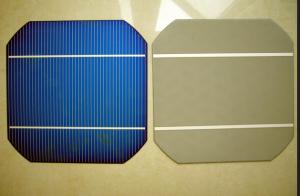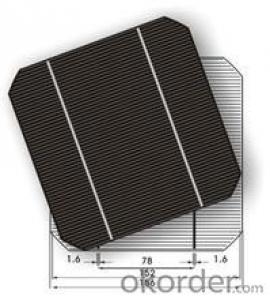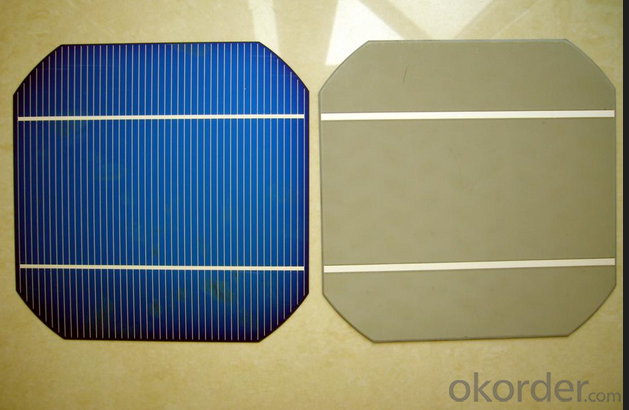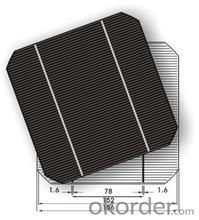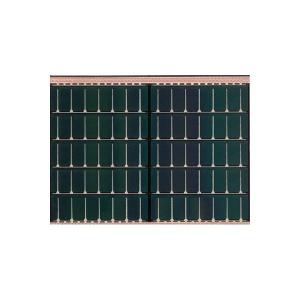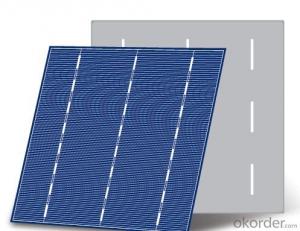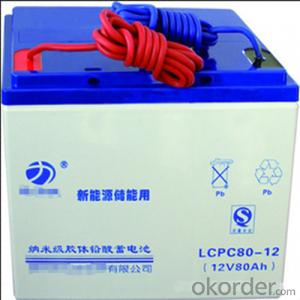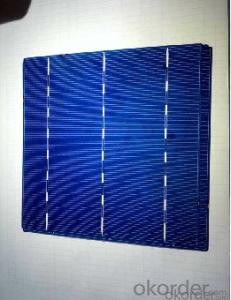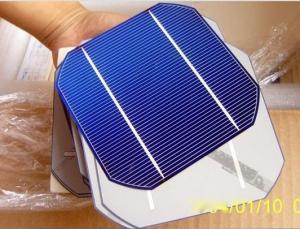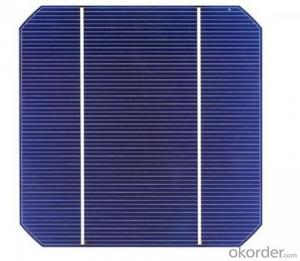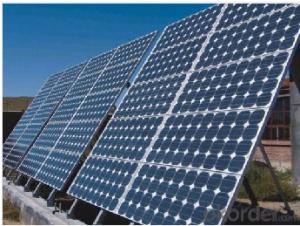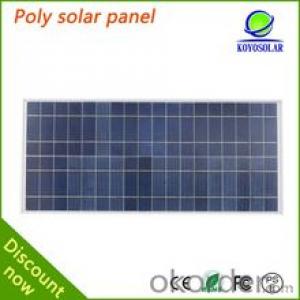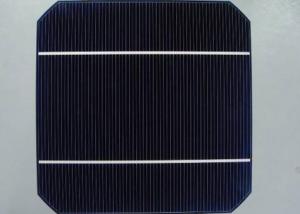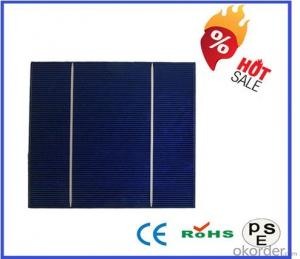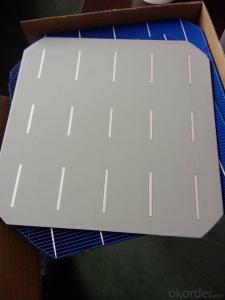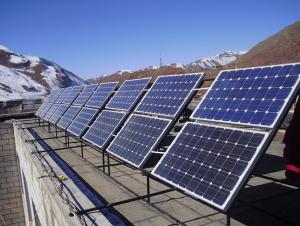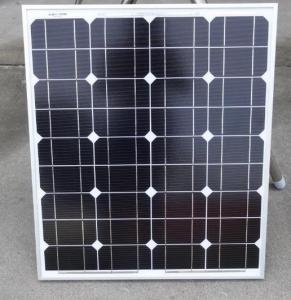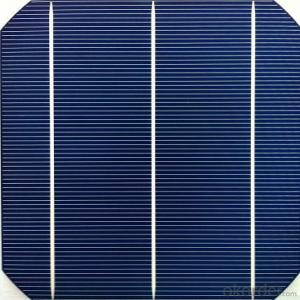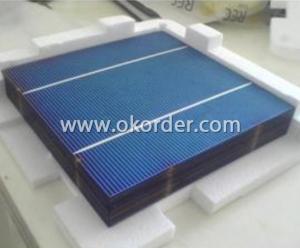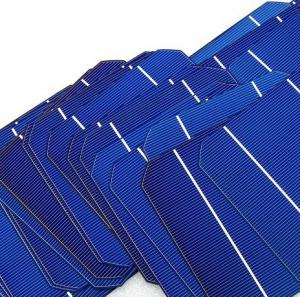Longi High Energy Conversion Efficiency Monocrystalline Silicon Solar Cells with Low Price
- Loading Port:
- China main port
- Payment Terms:
- TT or LC
- Min Order Qty:
- 1 m²
- Supply Capability:
- 100000000000000 m²/month
OKorder Service Pledge
OKorder Financial Service
You Might Also Like
1. Monocrystalline Silicon Solar Cells
OKorder is offering high quality Monocrystalline Silicon Solar Cells at great prices with worldwide shipping. Solar cells are the core of solar power systems and our Monocrystalline solar cells consist of an anisotropically texturized surface and dark silicon nitride, anti-reflection coating and a full-surface aluminum back-surface field. These Monocrystalline solar modules are perfect for converting solar energy into electric energy, or charging storage batteries.
2. The intended use of Monocrystalline Silicon Solar Cells
Our Monocrystalline Silicon Solar Cells are ideal for:
Power generation
Lighting
3. The advantages of Monocrystalline Silicon Solar Cells
Not only are OKorder's Monocrystalline Silicon Solar Cells of the highest quality and reliability, we are able to quickly ship orders within 20 days of receiving a deposit or original L/C.
4. Main features of Monocrystalline Silicon Solar Cells
Extended service life
Outstanding power output even in low light or high temperature conditions
High energy conversion efficiency
Reliable performance
Color uniformity
Low breakage rate
Optimized design for ease of soldering and lamination
5. FAQ:
Q1: Why buy Materials & Equipment from OKorder.com?
A: All products offered byOKorder.com are carefully selected from China's most reliable manufacturing enterprises. Through its ISO certifications, OKorder.com adheres to the highest standards and a commitment to supply chain safety and customer satisfaction.
Q2: What is a solar cell?
A: A solar cell is an electrical device that converts light energy directly into electricity by a phenomenon called the photovoltaic effect. When exposed to light, solar cells can generate and support an electric current without being attached to any external voltage source, but do require an external load for power consumption.
Q3: What are the advantages and disadvantages of monocrystalline solar PV cells?
A: Monocrystalline solar cells are the most efficient type of PV cells, with the exception of CdTe thin film solar PV cells. As a result, monocrystalline solar cells are more expensive when compared to almost all other types of cells.
Q4: What is the typical service life of solar PV modules?
A: The typical life of a PV module is 25 years. However, superior quality PV modules boast service lives up to 35-40 years (electrical generating capacity is often reduced, however by that point).
Q5: What certifications do you have?
A: We are specialized in the photovoltaic field, with a focus on solar cells, modules and photovoltaic power generation systems. We employ advanced monocrystalline and polycrystalline silicon solar cell manufacturing equipment, producing highly efficient and reliable products sold in Europe, the Americas and Australia. Our company has passed ISO9001 quality management system certification, and our products have obtained TUV-IEC, CE, UL certification.
Q6: How do we guarantee the quality of our products?
A: We have established an advanced quality management system which conducts strict quality tests at every step, from raw materials to the final product. At the same time, we provide extensive follow-up service assurances as required.
Q7: How soon can we receive the product after purchase?
A: Within three days of placing an order, we will begin production. The specific shipping date is dependent upon international and government factors, but is typically 7 to 10 workdays.
6. Specifications:
Dimension: 156mm x 156mm
Diagonal: 200mm (round chamfers)
Front: Anisotropically texturized surface and dark silicon nitride
anti-reflection coating
1.9mm silver bus bars
Back: Full-surface aluminum back-surface field
2.0mm (silver / aluminum) continuous soldering pads

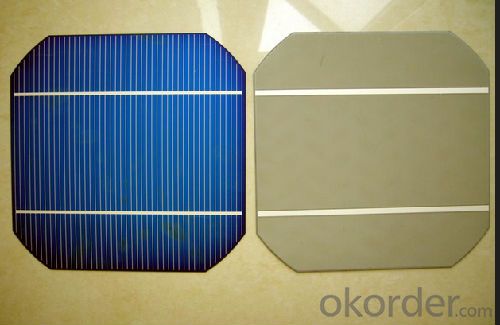
Brief introduction of Monocrystalline Silicon Solar Cells
Monocrystalline silicon solar cells based on high-purity silicon rods as raw material for solar cells, is currently the fastest development of a solar cell. Its structure and the production process has been finalized, the products have been widely used in space and on the ground.
In order to reduce production costs, ground applications such as solar cells using solar grade silicon rods, materials performance has been relaxed. Some also use semiconductor device processing materials and discard the head and tail of silicon materials, solar cells drawn into complex dedicated silicon rods. The silicon rods cut into pieces, usually 0.3 mm thick sheet. After polishing, cleaning and other processes, the raw material will be made of silicon.
In the processing of making solar cells, the first doping and diffusion in silicon, a trace amount of dopant is generally boron, phosphorus, and antimony. Diffusion is carried out in a quartz tube into a high-temperature diffusion furnace. Thus formed P> N junction on the wafer. Then using a screen printing method, fine with a good paste into a grid line printed on the wafer, after sintering, while forming the back electrode and the surface coated with antireflection gate line source to prevent a large number of photons It is reflected off the smooth surface of the wafer.
Thus, the monomer monocrystalline silicon solar cells are produced. After single-chip random testing can be assembled according to the required specifications into a solar cell module (solar panel) by the method of series and parallel to a certain output voltage and current. Finally, package the frame and materials. According to user system design, solar cell components of various sizes square solar cells, also known as solar arrays. Photoelectric conversion efficiency of monocrystalline silicon solar cells are about 15%, the results of the laboratory also has reached more than 20%.
- Q:How much does a solar cell weigh?
- The weight of a solar cell typically varies depending on its size and type, but on average, a standard solar cell weighs around 3 to 4 pounds (1.4 to 1.8 kilograms).
- Q:What is the solar cells market in China?
- Solar cells, is the "ideal" energy of human being's life, solar energy has changed the traditional way of obtaining energy by battery technology. But this technology is limited due to what solar cells needs to work- the weather factors, the solar energy battery can not work properly under rainy or cloudy weather. Therefore, solar cells market is not very well developed in some part of China where there are not much sun.
- Q:Can solar cells be used in underwater vehicles?
- Yes, solar cells can be used in underwater vehicles. However, due to the limited availability of sunlight underwater, the efficiency of solar cells is significantly reduced compared to their performance on the surface. Therefore, other power sources such as batteries or fuel cells are often used in conjunction with solar cells to provide continuous power to underwater vehicles.
- Q:Is that true that the price of solar cells will be reduced in the coming year?
- According to the research and survery we did recently in the 2nd tier cities in China, the possibility of the solar cells' price going down is very low. Reasons? All the solar cells project hasn't started yet at the end of the last year in the 2nd tier cities in China. The market won't allow the price to go down.
- Q:Can solar cells be used to power electric vehicles?
- Yes, solar cells can be used to power electric vehicles. Solar cells can convert sunlight into electricity, which can then be used to charge the batteries of electric vehicles. This technology is being explored and implemented in various forms, such as solar panels integrated into the roof or body of the vehicle, to provide additional power and extend the range of electric vehicles.
- Q:What is the average lifespan of a solar cell?
- The average lifespan of a solar cell is typically around 25 to 30 years.
- Q:Can solar cells be used in off-grid systems?
- Yes, solar cells can be used in off-grid systems. Off-grid systems, also known as standalone systems, are independent of the traditional electrical grid, and solar cells are a reliable and cost-effective way to generate electricity in such systems. By harnessing sunlight and converting it into electricity, solar cells can provide a sustainable and renewable energy source for off-grid applications such as remote cabins, boats, or even emergency backup power systems.
- Q:What is the role of trackers in solar cell systems?
- Trackers in solar cell systems are devices that help optimize the performance of solar panels by following the movement of the sun throughout the day. Their role is to ensure that the solar panels are always facing the sun at the optimal angle, maximizing the amount of sunlight they receive. This leads to increased energy production and improved efficiency of the solar cell system.
- Q:What is the average lifespan of a solar cell in space?
- The average lifespan of a solar cell in space can vary depending on several factors, such as the quality of the materials used, exposure to radiation, and maintenance. Generally, solar cells in space are designed to last anywhere from 10 to 25 years, but some have been known to continue functioning well beyond that timeframe.
- Q:What is the typical size and weight of a solar cell?
- The typical size of a solar cell ranges from a few square centimeters to several square meters, depending on its application. In terms of weight, solar cells are generally lightweight, weighing anywhere from a few grams to a few kilograms, again depending on their size and technology.
1. Manufacturer Overview |
|
|---|---|
| Location | |
| Year Established | |
| Annual Output Value | |
| Main Markets | |
| Company Certifications | |
2. Manufacturer Certificates |
|
|---|---|
| a) Certification Name | |
| Range | |
| Reference | |
| Validity Period | |
3. Manufacturer Capability |
|
|---|---|
| a)Trade Capacity | |
| Nearest Port | |
| Export Percentage | |
| No.of Employees in Trade Department | |
| Language Spoken: | |
| b)Factory Information | |
| Factory Size: | |
| No. of Production Lines | |
| Contract Manufacturing | |
| Product Price Range | |
Send your message to us
Longi High Energy Conversion Efficiency Monocrystalline Silicon Solar Cells with Low Price
- Loading Port:
- China main port
- Payment Terms:
- TT or LC
- Min Order Qty:
- 1 m²
- Supply Capability:
- 100000000000000 m²/month
OKorder Service Pledge
OKorder Financial Service
Similar products
Hot products
Hot Searches
Related keywords
